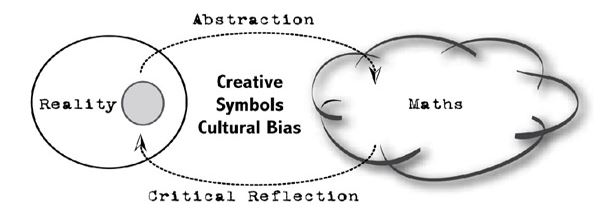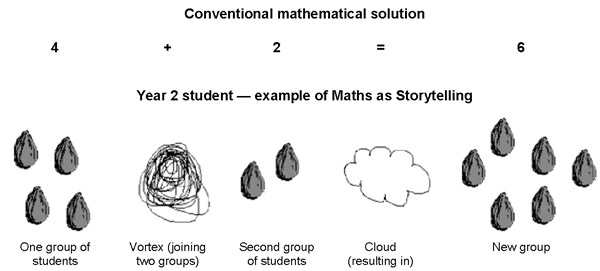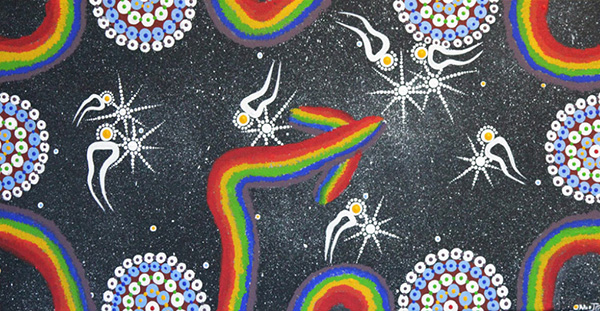This resource supports teachers to embed Aboriginal and Torres Strait Islander perspectives into the teaching and learning of mathematics. This approach can benefit the teacher and students in any classroom.
The QCAA thanks Dr Chris Matthews, an Aboriginal man from the Quandamooka Nation (Moreton Bay, Queensland), for his contribution to the development of this resource, through both personal consultation and his writings.
Background information
Culture affects the ways mathematics is learned. To understand the cultural aspects of mathematics, it is necessary to know what mathematics is. Figure 1 summarises Dr Matthews’ view on the fundamental question of the epistemology of mathematics. Developing pedagogy that is centred on this cycle can lead to authentic mathematical literacy.

Explaining the cycle
Dr Matthews argues that most students (Indigenous and non-Indigenous) only experience mathematics in its abstract form (i.e. they stay within the cloud), and do not experience and appreciate the cycle of abstraction and critical reflection.
Students can develop mathematical understanding by:
- choosing a particular part of reality (represented by the grey circle)
- creating an abstract representation of a real-life situation, using a range of mathematical symbols, which are combined to form a symbolic language we call mathematics
- using mathematics in its abstract form to explore particular attributes and behaviours of the real-life situation and then mathematically communicating these ideas to others
- critically reflecting on their mathematical representation to ensure that it fits with the observed reality.
Consequently, the abstraction and critical reflection processes form an important cycle in which mathematics and its knowledge are created, developed and refined.
The MAST approach
Maths as Storytelling (MAST) is a pedagogical approach that originated from the model in Figure 1. Dr Matthews developed this approach in a research project to explore new ways of teaching algebra to students who are underachieving. The approach focuses on stories, and explores how symbols and their meanings can communicate these stories.
The five steps of the Maths as Storytelling process are described below. Students:
- explore the meaning of symbols and how symbols can be used to tell and create a story
- explore simple equations by acting out a story and identifying its mathematical elements
- create their own symbols to represent the story using concrete materials

Figure 2. Example of mathematical reasoning of a Year 2 student
Figure 2 demonstrates an example from a Year 2 student who used the MAST approach. When the student was asked what his symbols meant, he explained his mathematical story: a vortex sucks the two groups together and the cloud gently places them down. - share their symbols with the group (this step gets students used to writing within different symbol systems, and helps develop a standard classroom symbol system)
- modify the story (a key step in introducing algebraic ideas) with help from the teacher.
MAST in the classroom
The MAST approach can help students understand more complicated equations, e.g. algebra. In Dr Matthew’s publication, Creating your own symbols: Beginning algebraic thinking with Indigenous students, this Year 8 class situation was described.
- Students were asked why equation 2x = 8 was divided by 2 to find x.
- Students were asked to represent the equation in a creative manner with two xs on one side of a line, and eight circles on the other.
- Students were then able to see that dividing both sides in two (see diagram below) will give the value of x.


The teacher believed that this could not have been done without the students having previously experienced the MAST approach. In addition, students also expressed a sense of freedom in being involved in creative activities, shifting the focus away from conventional mathematical symbols to an approach that focuses on the underlying meaning and structure of mathematics.
Questions for teachers to consider

- Do you understand the meaning of the symbols or story in the artwork above?
- What would help you to understand the meaning?
- Could this help you to understand what would help students gain an understanding of maths symbols?
- Is the way that you teach maths engaging all students in your classroom?
- How could the maths as storytelling process be implemented in your classroom?
- How would this process benefit students — both Aboriginal and Torres Strait Islander and non-Indigenous students — in the classroom?
- How could presenting this as an Indigenous process show Aboriginal and Torres Strait Islander students that their culture is valued in the classroom?
- How could this help non-Indigenous students to gain some understanding about Indigenous culture and processes?
More information
- ‘Creating your own symbols: Beginning algebraic thinking with Indigenous students’
by C Matthews, T Cooper & A Baturo 2007. In Woo Jeong-Ho, Lew Hee-Chan, Park Kyo-Sik, & Seo Dong-Yeop (Eds.) 31st Annual Conference of the International group for the Psychology of Mathematics Education, 8–13 July, 2007, Seoul: Korea.


